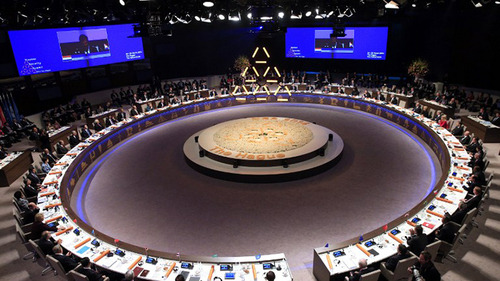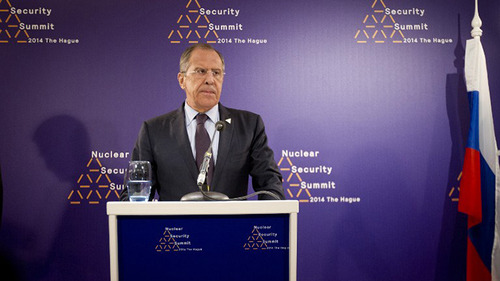Haneul Na’avi
27 March 2014
Diplomats from around the world have concluded the third bi-annual Nuclear Security Summit in The Hague, Netherlands. It was the third such event to take place, following the 2012 conference in the South Korean capital of Seoul and the first in Washington, DC, in the United States.
Worldwide leaders convened on 24-25th March to engage in dialogue about international nuclear security through their platform at the World Forum. 53 nations and their delegates were represented, and four additional international institutions—the European Council, the European Commission, INTERPOL, and the United Nations— sat in as observers of the meeting.

2014 Nuclear Security Summit Round Table (APF Photo/ Yves Logghe)
The conference entailed three focal points in its agenda, which outlined plans for reducing the present amounts of nuclear materials, improving security measures on current radioactive materials, and continuing international cooperation between countries. Many key members, including President Barack Obama of the United States, PM Mark Rutte of the Netherlands, International Atomic Energy Agency (IAEA) Director General Yukiya Amano, and Russian Foreign Minister Sergey Lavrov, interacted with audiences through speeches which highlighted their commitments to adhering to NSS objectives.
Prime Minister Rutte, in his address to the forum, announced that the majority of NSS member states were making great efforts to achieve these goals as recommended by the IAEA, and that he was hopeful that they could accomplish them by the upcoming 2016 Summit scheduled to take place in Chicago, Illinois. He noted that two-thirds of all NSS countries, under the initiative of the United States, South Korea, and the Netherlands, “have pledged to incorporate these important IAEA recommendations into their national legislation.”
“I conclude — two days ago, I used a football metaphor when I said that the ball was on the penalty spot. As chair of this edition of the NSS, I’m delighted that the NSS countries and organizations have scored a goal and that we have taken another step towards making the world safer. But we are not there yet. The NSS process will continue and in two years we’ll meet again to raise the bar even higher in all our interests,” Rutte commented in his presentation.

US President Obama and Netherlands PM Rutte Shaking hands during the summit (Pool, Getty Images Europe)
President Barack Obama articulated his perspectives and aims during his portion of the speech, and thanked King Williem-Alexander, PM Mark Rutte and the people of the Netherlands for their organization and hospitality. “To all the people who were involved in putting this together, including those who were putting up with the traffic that I caused, I want to say thank you,” he joked shortly afterwards.
He later discussed his enthusiasm over the endeavors being made to secure nuclear materials globally, including upgrading cybersecurity deterrents and improving further security protocols amongst nations and institutions to prevent Highly Enriched Uranium (HEU) from ending up in the hands of rouge groups and terrorists.
“I’ve made it clear that the United States will continue to do our part as well. Our nuclear regulator will develop new guidelines to strengthen cybersecurity at our nuclear power plants. And we’ve pledged to pursue the production of a key medical isotope used to treat illnesses like cancer without relying on weapons-usable material. We’re also going to work with our partners around the world to install more radiation detection equipment at ports and transit sites in order to combat nuclear smuggling,” Obama reassured during his speech.
In his address, Director General Yukiya Amano highlighted the achievements of 125 nations adhering to the declaration created during the Ministerial Conference on Nuclear Security of 2013, which outlined 24 critical focal points for ensuring the security of nuclear materials around the world, in addition to combatting nuclear terrorism that could threaten the safety of nations as well as environmental integrity.

IAEA Director General Yukiya Amano at a small press meeting (Sean Gallup/ Getty Images Europe)
“I count on your continued support for the IAEA nuclear security programme, and I ask you to maintain constant vigilance so that nuclear and other radioactive materials, which benefit humanity in so many ways, are never used intentionally to inflict harm,” Amano stated before the convention. He also encouraged countries to utilize the services of the IAEA to “organize expert peer reviews of their nuclear security arrangements.”
Russian Foreign Minister Sergey Lavrov, setting aside current objections about Crimea made by President Obama and PM Rutte, focused on the Summit’s objectives, concurred about the importance of transparency and cooperation amongst nation-states, and called attention to initiatives made by the Russian Federation to help control of nuclear fissile supplies. “In September 2012, the “Strazh-2012” training was organised in the Moscow Region, within the framework of the Global Initiative for the Suppression of Acts of Nuclear Terrorism, where experts from over 50 countries were present,” mentioned Lavrov.

Russian Foreign Minister Sergey Lavrov (APF Photo/ Evert-Jan Daniels)
The Russian Foreign Minister went on to highlight the achievements of the program, noting that “790 kg of fresh and 1269 kg of irradiated HEU have been removed from 14 countries in 12 years,” and further added that it was important for countries at the helm of the Nuclear Summit to “adhere to a universal nature to the fundamental international and legal documents in the PNS area, ensuring faster accession of all states to them,” specifically commenting on Nawaz Sharif, Prime Minister of Pakistan’s address.
All participating countries and organizations of the Summit chartered an official and final communiqué, which outlined agreements on shared objectives, emphasized the role of the IAEA and United Nations in the architecture of international security, and encouraged non-member states of the Convention on the Physical Protection of Nuclear Material (CPPNM) to join. The communiqué also underlined the legal instruments to be used for the processes, and created concise definitions of nuclear materials to come under scrutiny, including that of highly enriched uranium and plutonium. The document further clarified the sentiments of the Summit that, “continuous efforts are needed to achieve our common goal of strengthening the international nuclear security architecture and we recognize that this is an ongoing process”.
